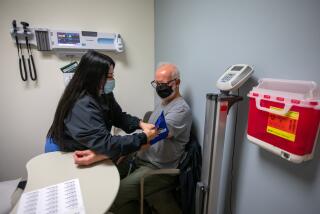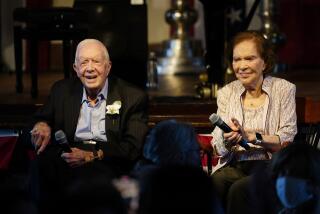Geriatric doctor doesn’t shy from tough talk
Gene Dorio, an old-school doctor who makes house calls in Santa Clarita, drives a 1990 Volvo with 362,000 miles on the clock and duct tape holding things together. His patients have a lot of miles on them, too. Dorio is a geriatric physician.
“Medical technology allows us to live longer, but is it with the quality of life we want?” Dorio wrote after reading a column I wrote about my father’s failing health. “The discussions are avoided and I believe physicians are responsible for this,” Dorio went on. “For some, dementia sets in, but for those who remain cognizant of mind and body, life can dribble away. Who can say when enough is enough?”
It’s not an easy question to answer, because as Dorio pointed out when I went to visit him, there’s always something else doctors can do — surgery, meds, experimental treatment — to give terminally ill patients a little more time. But an estimated 25% of Medicare dollars are spent on those in the last year of life, with medical procedures often rising in cost as health deteriorates.
There’s virtually no honest political discourse about this, though, and it’s not just politicians who have failed. It’s those of us who live in denial, unwilling to have uncomfortable conversations with loved ones, only to suddenly find that it’s too late.
When I got word that my father had fallen and broken his hip after many years of heart failure and other major medical issues, part of me was ready to say that’s it, let’s let him go. But he’s the type who would fight for every breath. What if the surgery, which he eventually underwent, keeps him breathing two more years in a state that he considers worth living, even if I wouldn’t make the same choice for myself?
Families should be having those conversations in advance of a crisis, said Dorio, who sees about 80% of his 300 patients in their homes and the remainder in the hospital. Dorio knows from experience that it costs less to keep elderly patients in their homes, where they prefer to be, than in hospitals or nursing homes. Palliative and hospice care reduce the number of ambulance runs, and in some cases, the amount of suffering, so the less costly route can also be the most humane.
“No one wants to be anywhere other than in their home,” Dorio said of his terminal patients.
But doctors have to break the news no one wants to hear, Dorio said. They have to compassionately but directly tell patients they’re very sick, that death is not optional, and help them determine what risks and discomfort they’re willing to take for more time. Do they want to go on living when the fog moves in, when they no longer know what day it is, and loved ones become strangers?
“If you look on the board at the hospital, there might be 30 patients there and only a few of them have ‘No Code Blue,’ ‘DNR.’ Mine are often the only patients who have Do Not Resuscitate,” said Dorio. “The majority are full code,” meaning they want extraordinary measures taken to keep them alive in a crisis.
Dorio has full-code patients, too. We visited one in Henry Mayo Hospital, a 90-year-old woman who’d just had hip surgery. She was vibrant, with a sharp mind, and she has told Dorio that if she has any setbacks, she wants to fight through them. That’s fine, he told me. At least they’ve had the conversation.
We also visited a brand new patient – a woman with mild dementia who’d taken a fall in her home, where she’s cared for by a live-in aide and a daughter who’s a nurse. Dorio spent more than an hour gently assessing the woman’s condition, and he feared a lower back fracture, a hunch that scans would later confirm.
Not many people have the luxury, Dorio said, of a trained nurse in the family and the ability to pay for full-time in-home care. But he believes a redistribution of Medicare and private insurance funds, away from hospital and nursing home stays and toward more palliative and hospice care, would make it possible for more sick, elderly people to remain at home, with the people they love.
Dorio told me about a critically ill patient in his 80s who emphatically made clear that he wanted no extraordinary measures taken to save him, though he hoped to live long enough to see his granddaughter’s bat mitzvah nine months away. Dorio encouraged the family to videotape his congratulations.
Six months later the patient deteriorated and was rushed to the emergency room, where he reiterated his desire not to be resuscitated. Only IV fluids and antibiotics for a blood infection were administered, and he faded over the next few days. But then he suddenly and unexpectedly recovered, only to lash out at Dorio for saving his life.
“I don’t want to live this way,” Dorio recalls him saying, and the man ordered that the antibiotics and IV drip be stopped. He died the next day.
Dorio later got a note from one of the man’s daughters, saying the bat mitzvah video was “not only a wonderful remembrance, but kindled a determination in her daughter to move forward in life.”
Making the rounds with Dorio in Santa Clarita, I found myself wishing I’d met him several years ago, when my dad was still relatively healthy. In my family, we’ve never found a way to discuss the complicated and unsettling questions of how much intervention my parents would want to prolong life, and under what circumstances they’d rather say goodbye.
It’s a conversation we still need to have.







